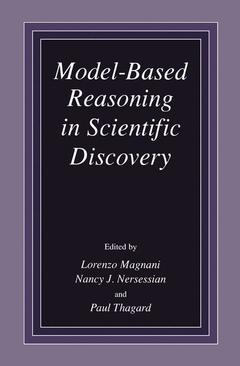Model-Based Reasoning in Scientific Discovery, Softcover reprint of the original 1st ed. 1999
Langue : Anglais
Coordonnateurs : Magnani L., Nersessian N.J., Thagard Paul

The volume is based on the papers that were presented at the Interna tional Conference Model-Based Reasoning in Scientific Discovery (MBR'98), held at the Collegio Ghislieri, University of Pavia, Pavia, Italy, in December 1998. The papers explore how scientific thinking uses models and explanatory reasoning to produce creative changes in theories and concepts. The study of diagnostic, visual, spatial, analogical, and temporal rea soning has demonstrated that there are many ways of performing intelligent and creative reasoning that cannot be described with the help only of tradi tional notions of reasoning such as classical logic. Traditional accounts of scientific reasoning have restricted the notion of reasoning primarily to de ductive and inductive arguments. Understanding the contribution of model ing practices to discovery and conceptual change in science requires ex panding scientific reasoning to include complex forms of creative reasoning that are not always successful and can lead to incorrect solutions. The study of these heuristic ways of reasoning is situated at the crossroads of philoso phy, artificial intelligence, cognitive psychology, and logic; that is, at the heart of cognitive science. There are several key ingredients common to the various forms of model based reasoning to be considered in this book. The models are intended as in terpretations of target physical systems, processes, phenomena, or situations. The models are retrieved or constructed on the basis of potentially satisfying salient constraints of the target domain.
Models, Mental Models, and Representations.- Model-Based Reasoning in Conceptual Change5.- Tracing the Development of Models in the Philosophy of Science.- Using Models to Represent Reality.- Models and Diagrams within the Cognitive Field.- Theories, Models, and Representations.- How Scientists Build Models InVivo Science as a Window on the Scientific Mind.- Discovery Processes and Mechanisms.- A Simulation of Model-Based Reasoning about Disparate Phenomena.- Scientific Discovery and Technological Innovation: Ulcers, Dinosaur Extinction, and the Programming Language Java.- A Hierarchy of Models and Electron Microscopy.- Expansion and Justification of Models: the Exemplary Case of Galileo Galilei.- Simplifying Bayesian Inference: the General Case.- Complexity versus Complex Systems: A New Approach to Scientific Discovery.- Creative Inferences and Abduction.- Model-Based Reasoning in Creative Processes.- Model-Based Creative Abduction.- Abduction and Geometrical Analysis. Notes on Charles S. Peirce and Edgar Allan Poe.- The Hierarchy of Models in Simulation.- Fictionalism and the Logic of “As If” Conditionals.- Scientific Modeling: A Multilevel Feedback Process.- Author Index.
Date de parution : 10-2012
Ouvrage de 343 p.
15.5x23.5 cm
Thèmes de Model-Based Reasoning in Scientific Discovery :
© 2024 LAVOISIER S.A.S.



